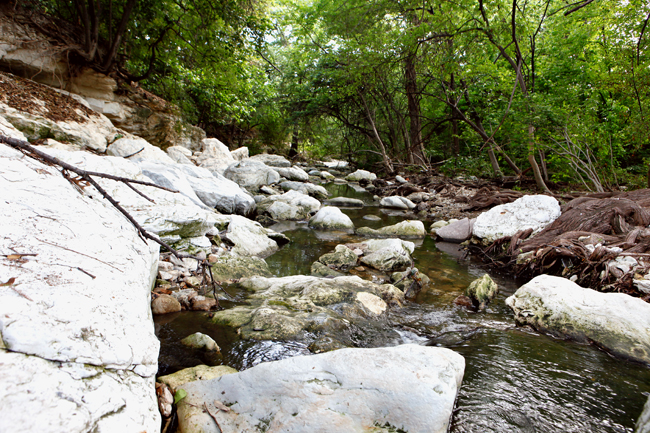For Travis LaDuc, UT’s assistant curator of herpetology, wading through Waller Creek to grab snakes is part of what he calls “snake CSI.”
LaDuc, assistant curator at the Texas Natural Science Center, tracks and studies blotched water snakes, a species of nonvenomous water snake that lives throughout Texas. LaDuc said the snakes could potentially be harmed by the construction of a tunnel under Waller Creek if it physically divides the population.
Every six weeks, LaDuc and several students go out to the creek to capture the snakes and collect data on their habits and habitat preferences. He uses both microchips and radio technology, which he inserts into the snakes under anesthesia in order to track them.
“It’s a serendipitous sport,” LaDuc said. “You see a snake, reach in to grab it and hope you come up with one. The radio telemetry lets us track snakes 24/7, so we get an overall snapshot of the creek and how they use their habitat.”
Biology junior Andrew Coulter, who went out to track and study the snakes in his vertebrate natural history class, said working with snakes allowed him to learn more about their behavior and misconceptions people have about snakes.
“I feel like a lot of people think they’re aggressive and want to bite you, but they’re actually pretty calm,” Coulter said.
LaDuc said he chose to study the snakes in Waller Creek because the population was large and easy to access.
“They’re the largest, most common snake in the area, so not a lot of people study them,” LaDuc said. “I wanted to find out how the population has been able to persist, despite everything that’s been thrown at it.”
Despite living near the University in an urban habitat, the snakes still manage to survive and thrive, according to LaDuc.
”People come out [to Waller Creek] all the time,” LaDuc said. “On game days, you have people tailgating and … disturbing the snakes’ habitat, but they seem to do just fine.”Chad Brock, biology graduate student, said snakes can be hard to find in a habitat.
“The most difficult thing about working with snakes can be, at least initially, finding them,” Brock said. “However, once you’ve found the appropriate habitat, they can actually be quite dense.”
According to LaDuc, there’s about one snake every 30 feet along Waller Creek, although most people don’t realize it. The snakes’ ability to camouflage may contribute to their success, LaDuc said.
“[They] have a mottled greenish-brown camouflage, so sometimes they can be hard to see,” LaDuc said. “People will literally almost step on them because they camouflage so well.” LaDuc said ongoing construction in Waller Creek could also potentially affect the snake population.
“The majority [of the snakes] don’t move great distances, but the tunnel could cut off any connectivity with Lady Bird Lake, so that could create a bottleneck where the population becomes genetically isolated over time,” LaDuc said
LaDuc said he gets bitten by a snake at least once every trip, but that doesn’t stop him from continuing his research.
“It’s not my favorite part, but snakes have teeth, and I would probably bite me too, if I were a snake, and some guy came and picked me up out of the creek,” LaDuc said. “Just having something hands-on, something you can wrangle with and get bitten by a few times, is what has always attracted me to snakes. They’re pretty amazing creatures."



















